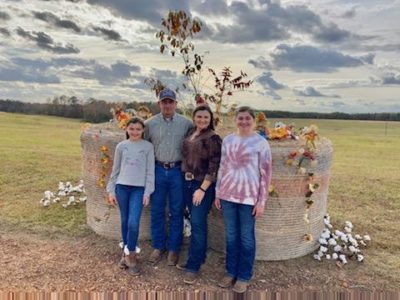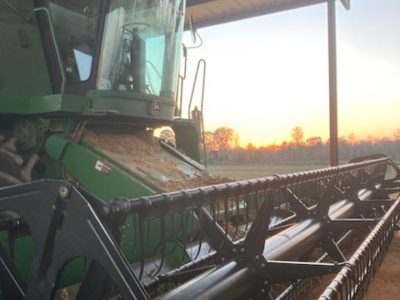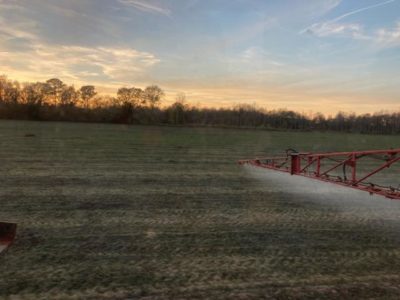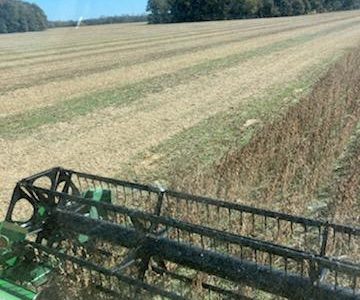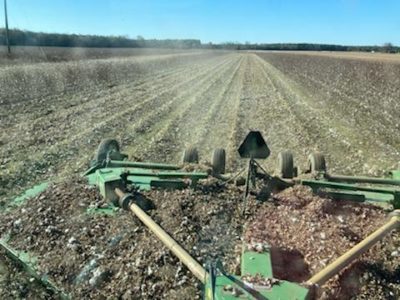 We finally finished harvesting our soybeans on November 24, marking the end of our very long harvest season. We started harvesting single-season soybeans on November 8. When we finished harvesting the single-crop soybeans, we moved right on into the double-crop soybeans, as they were ready to cut. Yields were really good in the single-crop soybeans and average for the double-crops, but we had unexpected challenges that made for long, frustrating days.
We finally finished harvesting our soybeans on November 24, marking the end of our very long harvest season. We started harvesting single-season soybeans on November 8. When we finished harvesting the single-crop soybeans, we moved right on into the double-crop soybeans, as they were ready to cut. Yields were really good in the single-crop soybeans and average for the double-crops, but we had unexpected challenges that made for long, frustrating days.
Cutting both our single-crop and double-crop soybeans took longer than anticipated, and that wasn’t just due to weather delays. This fall, we had green stem in our soybeans. Green stem is a condition where the soybean pods dry down as they should, so they are mature and ready for harvest, but the stems of the soybeans remain green. While we’ve seen green stem before, this is the most consistent and prevalent we’ve seen in all our fields, and it caused problems from the first to the last day of harvest.
 The green stems are very tough, making it harder for the cutter bar on the combine to slice through them and harder to break them up as they move through the machine. These were the toughest soybeans I’ve ever cut in my farming career. I had to drive very slowly through the fields. Green stem likely also contributed to our constant equipment breakdowns throughout November, and the farm’s service truck having to stay close to the combine in the field.
The green stems are very tough, making it harder for the cutter bar on the combine to slice through them and harder to break them up as they move through the machine. These were the toughest soybeans I’ve ever cut in my farming career. I had to drive very slowly through the fields. Green stem likely also contributed to our constant equipment breakdowns throughout November, and the farm’s service truck having to stay close to the combine in the field.
However, yields have been satisfying enough that we filled up our on-farm storage bins, filled our open contracts, sold a few loads to the buying point on the spot market and sold more soybeans directly from the field that will be used in our local market.
After we finished soybeans, our fourth and final crop to harvest, there wasn’t much time for celebration. We shifted our focus to start planting winter wheat. We’ve had so many challenges throughout harvest that I haven’t had time to get our peanut fields ready to plant. I usually cultivate all our peanut ground in preparation for planting. As I mentioned before, one of our goals is to get a no-till drill so we can plant winter wheat without having to work the ground. This fall, one of our neighbors had finished drilling rye grass and agreed to let us rent his no-till drill to plant our wheat. If we like how it works, it exceeds our yield expectations based on seed placement and emergence, and our financials work out, we hope to eventually buy a drill like it. Drilling wheat has a learning curve, but it did save a considerable amount of time because I didn’t have to make two trips through the field to prepare the seedbed. We simply burned down the fall and winter weeds with herbicide and drilled the wheat seed into the peanut vines and cotton stubble. Planting into the cotton stubble was a true experiment, as there is much more crop residue on the ground surface compared to the peanut vines. We are hopeful it will provide just as good a seed bed and produce great yields in both areas.
 When I haven’t been combining or planting wheat, I continue to chop cotton stalks with our rotary cutter so the plants don’t start regrowing. We’ve had several hard frosts at this point, so we should no longer have issues with basil regrowth, but this helps break down cotton stalk residue and makes it easier to plant cover crops.
When I haven’t been combining or planting wheat, I continue to chop cotton stalks with our rotary cutter so the plants don’t start regrowing. We’ve had several hard frosts at this point, so we should no longer have issues with basil regrowth, but this helps break down cotton stalk residue and makes it easier to plant cover crops.
We have managed to plant some cover crops, but we probably won’t be able to finish all the acres we’d like, due to it becoming too late in the season to receive a benefit.
Planting winter wheat and cover crops are the first steps in raising our 2022 crops. We have been planning for next season, even while we finish up this year. Before the combine is washed and placed under the barn for its long winter nap, we are already thinking about next year and preparing for spring.
Each year is different and presents its own set of challenges and rewards. Last year at this time, we were recovering from a hurricane in my region of the southern U.S., which cost us a cotton crop. And, we nearly lost our soybean crop. That meant we had extra fieldwork to do this spring, with tree removal and continued storm cleanup. We had copious amounts of rain throughout the late winter and early spring season, which delayed planting. Though we quickly made progress when we could, the rain continued and caused us to depend more on aerial applications than we usually do as the crops bloomed and grew. As crazy as it sounds, ample rains created challenges as we managed insects and diseases. However, those rains supported good yields throughout harvest. I’m very thankful for a good, safe harvest, especially knowing the types of challenges farmers in other parts of the U.S. have faced this year.
 As we round out this year, we are exhausted but excited to have finally reached the finish line. I want all to know that I am incredibly proud to be an American farmer, providing food, fuel and fiber for my family, your family and others across the world. In the U.S., we produce a very safe, sustainable food supply. My hope is that by sharing my story and how we farmed this year, you have seen how we pour our hearts and souls into what we grow. When purchasing U.S.-grown commodities, you can be confident we’ve done everything we can to raise high-quality, sustainable crops.
As we round out this year, we are exhausted but excited to have finally reached the finish line. I want all to know that I am incredibly proud to be an American farmer, providing food, fuel and fiber for my family, your family and others across the world. In the U.S., we produce a very safe, sustainable food supply. My hope is that by sharing my story and how we farmed this year, you have seen how we pour our hearts and souls into what we grow. When purchasing U.S.-grown commodities, you can be confident we’ve done everything we can to raise high-quality, sustainable crops.
There isn’t any more land being made on this earth. Rest assured that we are taking good care of ours, because if we don’t take care of the land, it won’t take care of us! Thank you for following along with me on my farm this year. Remember, U.S. farmers are open for business, and work tirelessly to produce the highest quality crops we can to help feed the world.
This field update is funded by the soybean checkoff. To share or republish part or all of this Ground Work 2021 article, please link to the original article and credit www.USSOY.org.


